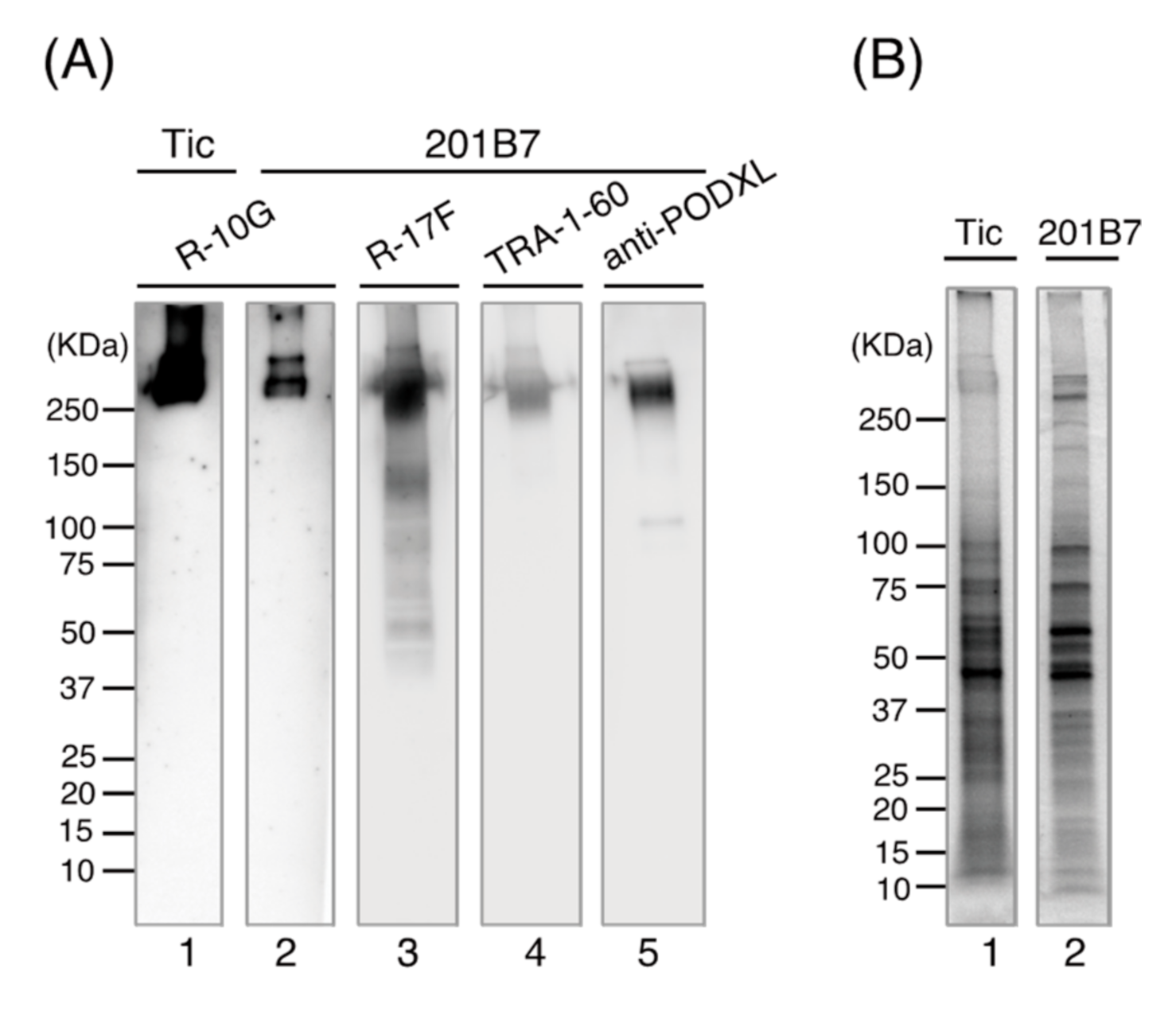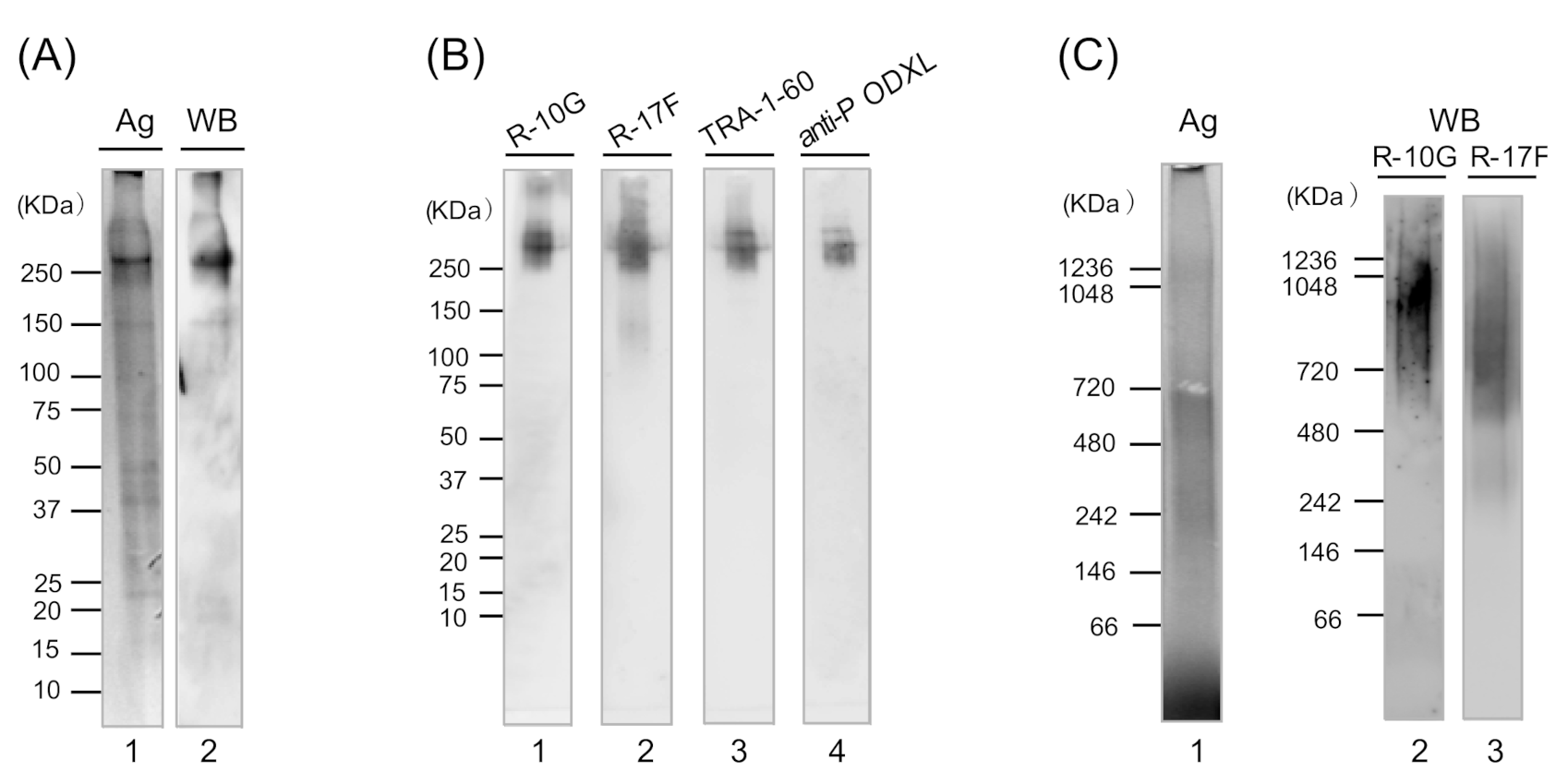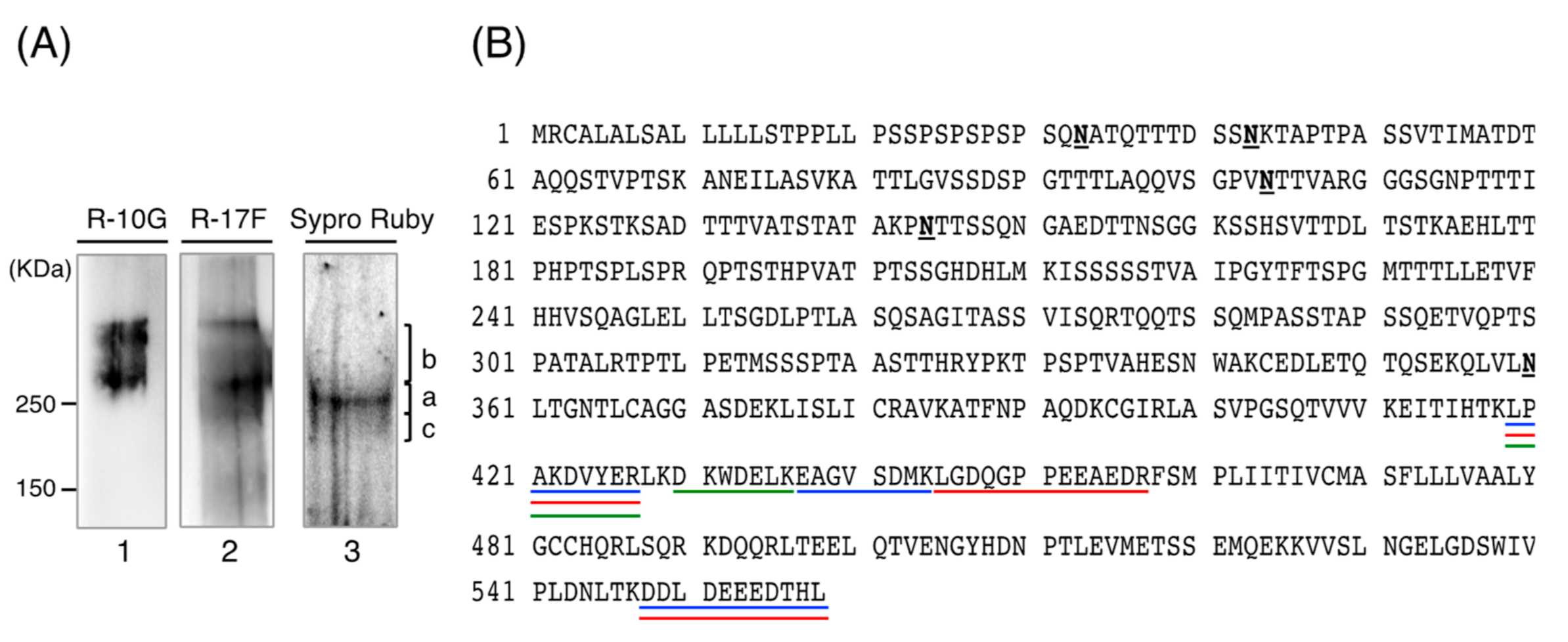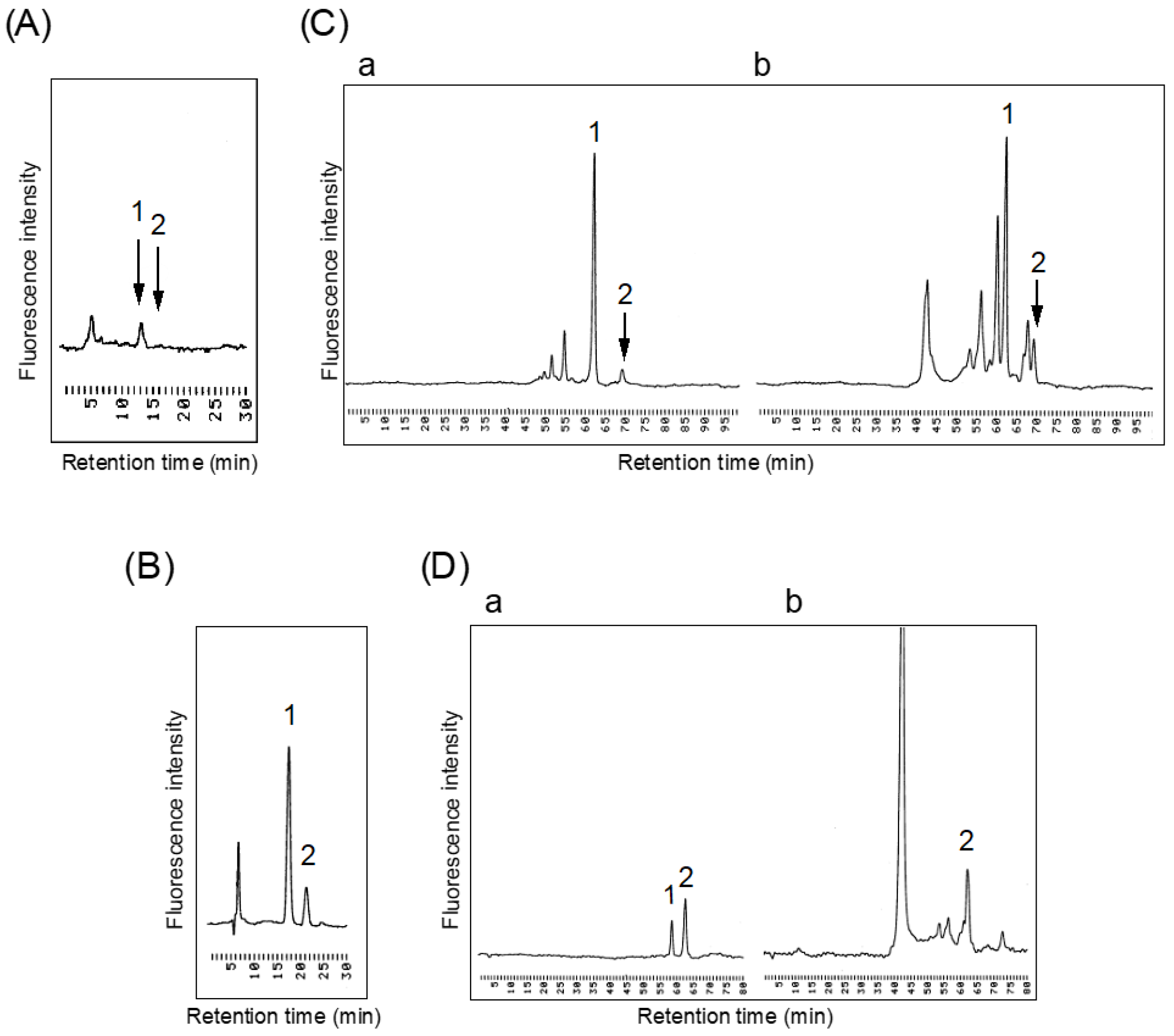Glycan Epitopes on 201B7 Human-Induced Pluripotent Stem Cells Using R-10G and R-17F Marker Antibodies
Abstract
1. Introduction
2. Materials and Methods
2.1. Antibodies and Enzymes
2.2. Cell Culture
2.3. Isolation of R-10G-Binding Protein from 201B7 Cells
2.4. SDS-PAGE and Western Blotting
2.5. Identification of the R-10G-Binding Protein in 201B7 Cells
2.6. Chemical Analysis of R-10G-Binding Protein in 201B7 Cells
3. Results
3.1. Glycan-Epitope Profiles of 201B7 Cells
3.2. Purification of the R-10G-Binding Protein from 201B7 Cells
3.3. Identification of the Purified R-10G-Binding Protein as Podocalyxin
3.4. Characterization of the Glycans of Purified R-10G-Binding Protein by Glycosidase Digestion
3.5. Chemical Analysis of the R-10G Epitope
4. Discussion
5. Conclusions
Supplementary Materials
Author Contributions
Funding
Institutional Review Board Statement
Informed Consent Statement
Acknowledgments
Conflicts of Interest
References
- Takahashi, K.; Tanabe, K.; Ohnuki, M.; Narita, M.; Ichisaka, T.; Tomoda, K.; Yamanaka, S. Induction of Pluripotent Stem Cells from Adult Human Fibroblasts by Defined Factors. Cell 2007, 131, 861–872. [Google Scholar] [CrossRef]
- Lanctot, P.M.; Gage, F.H.; Varki, A.P. The glycans of stem cells. Curr. Opin. Chem. Biol. 2007, 11, 373–380. [Google Scholar] [CrossRef]
- Kannagi, R.; Cochran, N.; Ishigami, F.; Hakomori, S.; Andrews, P.; Knowles, B.; Solter, D. Stage-specific embryonic antigens (SSEA-3 and -4) are epitopes of a unique globo-series ganglioside isolated from human teratocarcinoma cells. EMBO J. 1983, 2, 2355–2361. [Google Scholar] [CrossRef]
- Kannagi, R.; Levery, S.B.; Ishigami, F.; Hakomori, S.; Shevinsky, L.H.; Knowles, B.B.; Solter, D. New globoseries glyco-sphingolipids in human teratocarcinoma reactive with the monoclonal antibody directed to a developmentally regulated antigen, stage-specific embryonic antigen 3. J. Biol. Chem. 1983, 258, 8934–8942. [Google Scholar] [CrossRef]
- Andrews, P.W.; Banting, G.; Damjanov, I.; Arnaud, D.; Avner, P. Three Monoclonal Antibodies Defining Distinct Differentiation Antigens Associated with Different High Molecular Weight Polypeptides on the Surface of Human Embryonal Carcinoma Cells. Hybridoma 1984, 3, 347–361. [Google Scholar] [CrossRef] [PubMed]
- Kawabe, K.; Tateyama, D.; Toyoda, H.; Kawasaki, N.; Hashii, N.; Nakao, H.; Matsumoto, S.; Nonaka, M.; Matsumura, H.; Hirose, Y.; et al. A novel antibody for human induced pluripotent stem (hiPS) cells and embryonic stem (ES) cells recognizes a type of keratan sulfate lacking oversulfated structures. Glycobiology 2013, 23, 322–336. [Google Scholar] [CrossRef] [PubMed]
- Nakao, H.; Nagai, Y.; Kojima, A.; Toyoda, H.; Kawasaki, N.; Kawasaki, T. Binding specificity of R-10G and TRA-1-60/81, and substrate specificity of keratanase II studied with chemically synthesized oligosaccharides. Glycoconj. J. 2017, 34, 789–795. [Google Scholar] [CrossRef]
- Matsumoto, S.; Nakao, H.; Kawabe, K.; Nonaka, M.; Toyoda, H.; Takishima, Y.; Kawabata, K.; Yamaguchi, T.; Kusuda-Furue, M. A cytotoxic antibody recognizing lac-to-n-fucopentaose I (LNFP I) on human induced pluripotent stem (hiPS) cells. J. Biol. Chem. 2015, 290, 20071–20085. [Google Scholar] [CrossRef]
- Nakao, H.; Matsumoto, S.; Nagai, Y.; Kojima, A.; Toyoda, H.; Hashii, N.; Takakura, D.; Kawasaki, N.; Yamaguchi, T.; Kawabata, K.; et al. Characterization of glycoproteins expressing the blood group H type 1 epitope on human induced pluripotent stem (hiPS) cells. Glycoconj. J. 2016, 34, 779–787. [Google Scholar] [CrossRef]
- Natunen, S.; Satomaa, T.; Pitkänen, V.; Salo, H.; Mikkola, M.; Otonkoski, T.; Valmu, L. The binding specificity of the marker antibodies Tra-1-60 and Tra-1-81 reveals a novel pluripotency-associated type 1 lactosamine epitope. Glycobiology 2010, 21, 1125–1130. [Google Scholar] [CrossRef]
- Laemmli, U.K. Cleavage of structural proteins during the assembly of the head of bacteriophage T4. Nature 1970, 227, 680–685. [Google Scholar] [CrossRef] [PubMed]
- Towbin, H.; Staehelin, T.; Gordon, J. Electrophoretic transfer of proteins from polyacrylamide gels to nitrocellulose sheets: Procedure and some applications. 1979. Biotechnology 1992, 24, 145–149. [Google Scholar] [CrossRef] [PubMed]
- Nagai, Y.; Sakakibara, I.; Toyoda, H. Microdetermination of sialic acids in blood samples by hydrophilic interaction chro-matography coupled to post-column derivatization and fluorometric detection. Anal. Sci. 2019, 35, 517–520. [Google Scholar] [CrossRef]
- Toyoda, H.; Demachi, Y.; Komoriya, S.; Furuya, N.; Toida, T.; Imanari, T. Characterization and Determination of Human Urinary Keratan Sulfate. Chem. Pharm. Bull. 1998, 46, 97–101. [Google Scholar] [CrossRef][Green Version]
- Schägger, H.; von Jagow, G. Blue native electrophoresis for isolation of membrane protein complexes in enzymatically active form. Anal. Biochem. 1991, 199, 223–231. [Google Scholar] [CrossRef]
- Kerjaschki, D.; Sharkey, D.J.; Farquhar, M.G. Identification and characterization of podocalyxin—The major sialoprotein of the renal glomerular epithelial cell. J. Cell Biol. 1984, 98, 1591–1596. [Google Scholar] [CrossRef]
- Kershaw, D.B.; Beck, S.G.; Wharram, B.L.; Wiggins, J.E.; Goyal, M.; Thomas, P.E.; Wiggins, R.C. Molecular cloning and char-acterization of human podocalyxin-like protein Orthologous relationship to rabbit PCLP1 and rat podocalyxin. J. Biol. Chem. 1997, 272, 15708–15714. [Google Scholar] [CrossRef]
- Sassetti, C.; Tangemann, K.; Singer, M.S.; Kershaw, D.B.; Rosen, S.D. Identification of Podocalyxin-like Protein as a High Endothelial Venule Ligand for L-selectin: Parallels to CD34. J. Exp. Med. 1998, 187, 1965–1975. [Google Scholar] [CrossRef]
- Sassetti, C.; Van Zante, A.; Rosen, S.D. Identification of Endoglycan, a Member of the CD34/Podocalyxin Family of Sialomucins. J. Biol. Chem. 2000, 275, 9001–9010. [Google Scholar] [CrossRef]
- Nielsen, J.S.; McNagny, K.M. The Role of Podocalyxin in Health and Disease. J. Am. Soc. Nephrol. 2009, 20, 1669–1676. [Google Scholar] [CrossRef]
- Cait, J.; Hughes, M.R.; Zeglinski, M.R.; Chan, A.W.; Osterhof, S.; Scott, R.W.; Hernaez, D.C.; Cait, A.; Vogl, A.W.; Bernatchez, P.; et al. Podocalyxin is required for maintaining blood–brain barrier function during acute inflammation. Proc. Natl. Acad. Sci. USA 2019, 116, 4518–4527. [Google Scholar] [CrossRef] [PubMed]
- Schopperle, W.M.; DeWolf, W.C. The TRA-1-60 and TRA-1-81 human pluripotent stem cell markers are expressed on podo-calyxin in embryonal carcinoma. Stem Cells 2007, 25, 723–730. [Google Scholar] [CrossRef]
- Ito, M.; Hirabayashi, Y.; Yamagata, T. Substrate specificity of endo-beta-galactosidases from Flavobacterium keratolyticus and Escherichia freundii is different from that of Pseudomonas sp. J. Biochem. 1986, 100, 773–780. [Google Scholar] [CrossRef]
- Brown, G.M.; Nieduszynski, I.A.; Morris, H.G.; Abram, B.L.; Huckerby, T.N.; Block, J.A. Skeletal keratan sulphate structural analysis using keratanase II digestion followed by high-performance anion-exchange chromatography. Glycobiology 1995, 5, 311–317. [Google Scholar] [CrossRef]
- Fukuda, M.N.; Matsumura, G. Endo-beta-galactosidase of Escherichia freundii Orthologous relationship to rabbit PCLP1 and rat podocalyxin. J. Biol. Chem. 1976, 251, 6218–6225. [Google Scholar] [CrossRef]
- Oeben, M.; Keller, R.; Stuhlsatz, H.W.; Greiling, H. Constant and variable domains of different disaccharide structure in corneal keratan sulphate chains. Biochem. J. 1987, 248, 85–93. [Google Scholar] [CrossRef]
- Takeda-Uchimura, Y.; Uchimura, K.; Sugimura, T.; Yanagawa, Y.; Kawasaki, T.; Komatsu, Y.; Kadomatsu, K. Requirement of keratan sulfate proteoglycan phosphacan with a specific sulfation pattern for critical period plasticity in the visual cortex. Exp. Neurol. 2015, 274, 145–155. [Google Scholar] [CrossRef]
- Oguma, T.; Toyoda, H.; Toida, T.; Imanari, T. Analytical Method for Keratan Sulfates by High-Performance Liquid Chromatography/Turbo-Ionspray Tandem Mass Spectrometry. Anal. Biochem. 2001, 290, 68–73. [Google Scholar] [CrossRef]
- Satomaa, T.; Heiskanen, A.; Mikkola, M.; Olsson, C.; Blomqvist, M.; Tiittanen, M.; Jaatinen, T.; Aitio, O.; Olonen, A.; Helin, J.; et al. The N-glycome of human embryonic stem cells. BMC Cell Biol. 2009, 10, 42. [Google Scholar] [CrossRef]
- Furukawa, J.-I.; Okada, K.; Shinohara, Y. Glycomics of human embryonic stem cells and human induced pluripotent stem cells. Glycoconj. J. 2016, 33, 707–715. [Google Scholar] [CrossRef]
- Toyoda, H.; Nagai, Y.; Kojima, A.; Kinoshita-Toyoda, A. Podocalyxin as a major pluripotent marker and novel keratan sulfate proteoglycan in human embryonic and induced pluripotent stem cells. Glycoconj. J. 2017, 34, 789–795. [Google Scholar] [CrossRef] [PubMed]
- Wu, N.; Silva, L.M.; Liu, Y.; Zhang, Y.; Gao, C.; Zhang, F.; Fu, L.; Peng, Y.; Linhardt, R.; Kawasaki, T.; et al. Glycan Markers of Human Stem Cells Assigned with Beam Search Arrays*[S]. Mol. Cell. Proteom. 2019, 18, 1981–2002. [Google Scholar] [CrossRef] [PubMed]





| Carbohydrate | Molar Ratio |
|---|---|
| GalN (a) | 1.00 |
| GlcN | 4.00 |
| Neu5Ac | 1.01 |
| GlcNAcβ1-3Gal | 0.11 |
| GlcNAc(6S) β1-3Gal | 0.30 |
| Galβ1-4GlcNAc(6S) | 0.10 |
Publisher’s Note: MDPI stays neutral with regard to jurisdictional claims in published maps and institutional affiliations. |
© 2021 by the authors. Licensee MDPI, Basel, Switzerland. This article is an open access article distributed under the terms and conditions of the Creative Commons Attribution (CC BY) license (http://creativecommons.org/licenses/by/4.0/).
Share and Cite
Nagai, Y.; Nakao, H.; Kojima, A.; Komatsubara, Y.; Ohta, Y.; Kawasaki, N.; Kawasaki, N.; Toyoda, H.; Kawasaki, T. Glycan Epitopes on 201B7 Human-Induced Pluripotent Stem Cells Using R-10G and R-17F Marker Antibodies. Biomolecules 2021, 11, 508. https://doi.org/10.3390/biom11040508
Nagai Y, Nakao H, Kojima A, Komatsubara Y, Ohta Y, Kawasaki N, Kawasaki N, Toyoda H, Kawasaki T. Glycan Epitopes on 201B7 Human-Induced Pluripotent Stem Cells Using R-10G and R-17F Marker Antibodies. Biomolecules. 2021; 11(4):508. https://doi.org/10.3390/biom11040508
Chicago/Turabian StyleNagai, Yuko, Hiromi Nakao, Aya Kojima, Yuka Komatsubara, Yuki Ohta, Nana Kawasaki, Nobuko Kawasaki, Hidenao Toyoda, and Toshisuke Kawasaki. 2021. "Glycan Epitopes on 201B7 Human-Induced Pluripotent Stem Cells Using R-10G and R-17F Marker Antibodies" Biomolecules 11, no. 4: 508. https://doi.org/10.3390/biom11040508
APA StyleNagai, Y., Nakao, H., Kojima, A., Komatsubara, Y., Ohta, Y., Kawasaki, N., Kawasaki, N., Toyoda, H., & Kawasaki, T. (2021). Glycan Epitopes on 201B7 Human-Induced Pluripotent Stem Cells Using R-10G and R-17F Marker Antibodies. Biomolecules, 11(4), 508. https://doi.org/10.3390/biom11040508





